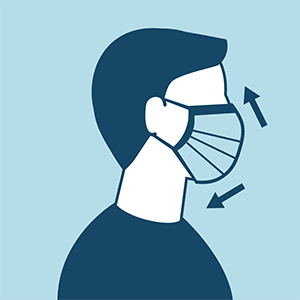 |
| Credit CDC |
#15,214
The public wearing of face masks during any respiratory outbreak is a long established cultural norm in many Asian countries, and in early December - in anticipation of this year's flu season, and before the Wuhan outbreak became known - Hong Kong's CHP published a tutorial on the subject (see HK CDW: Surgical Masks For Respiratory Protection).
Outside of Asia, at least until very recently, the public wearing of masks has been widely discouraged by many public health entities, citing a `lack of scientific evidence' of their effectiveness.
The practice has long been discouraged by the World Health Organization, including in their NPI recommendations from last year, and more recently in their WHO Interim Guidance: Advice On The Use Of Masks In The Context Of COVID-19.
The debate continues with a new letter, published in the CDC's EID Journal, which concedes the lack rigorous scientific data, and instead offers an epidemiological comparison between Taiwan - which recommended masks early in the pandemic - and Singapore, which only adopted the advice a couple of weeks ago.
Last January, in The Man In The Ironed Mask (Revisited), we looked at the studies (both pro and con) on the practice, and while their effectiveness appears fairly limited, my personal take is wearing one probably beats not wearing one at all.Admittedly, the science behind using face coverings in public is less than robust, but there is enough anecdotal evidence that nearly every Asian nation now recommends (or requires) the wearing of masks outside the home, and our own CDC recently recommended the practice for Americans (see The CDC's Cloth Face Cover Recommendations).
The debate continues with a new letter, published in the CDC's EID Journal, which concedes the lack rigorous scientific data, and instead offers an epidemiological comparison between Taiwan - which recommended masks early in the pandemic - and Singapore, which only adopted the advice a couple of weeks ago.
The data cited in this letter ( as of April 3rd) showed Singapore with an infection rate (per 100K) of 19.07 compared to Taiwan's 1.46. A 13-fold difference.As of today (April 23rd) the difference is even starker, with Taiwan reporting only 429 cases (1.78/100K) and Singapore now at 11,178 cases (199.6/100K), although much of Singapore's recent spike is attributed to foreign workers residing in dormitories (as opposed to community spread).
Taiwan's pro face mask policy is far from the only difference between these two countries, and so how much of Taiwan's success can be attributed to the wearing of face masks in public is unknown.But these are the sorts of datasets researchers will be closely analysing as we work through this pandemic, in hopes that we'll be better prepared for deal with the next one.
Letter
The Practice of Wearing Surgical Masks during the COVID-19 Pandemic
Cho-Han Chiang, Cho-Hung Chiang, Cho-Hsien Chiang, and Yee-Chun Chen
Author affiliations: National Taiwan University College of Medicine, Taipei, Taiwan (Cho-Han Chiang, Y.-C. Chen); Fu-Jen Catholic University, Taipei (Cho-Hung Chiang); Chung Shan Medical University, Taichung, Taiwan (Cho-Hsien Chiang); National Taiwan University Hospital, Taipei (Y.-C. Chen)
To the Editor: We read with interest the meta-analysis conducted by Xiao et al. (1) that found no significant reduction in influenza transmission with the use of surgical masks in the community, based on 10 randomized controlled trials. Nevertheless, mechanistic studies found that surgical masks could prevent transmission of human coronavirus and influenza virus infections if worn by infected persons (2). The authors pointed out the limitations of their study: small sample size and suboptimal adherence in the mask-wearer group (1). Recommendations on masks in the community vary across countries during the coronavirus disease (COVID-19) pandemic (3); studies have reported mixed results (2,4,5).
Epidemiologic data may provide an alternative insight. As of April 3, 2020, Taiwan recorded 348 COVID-19 cases (1.46/100,000 population), of which 48 (13.8%) were local cases. Singapore recorded 1,114 cases (19.07/100,000 population), of which 572 (51.3%) were local cases. Taiwan and Singapore both employed stringent measures. Taiwan recommended the use of masks early in the pandemic. In contrast, Singapore did not recommend the use of masks until April 3 and initiated its Stay Home policy on April 7.
Before the 2003 severe acute respiratory syndrome coronavirus epidemic in Taiwan, only persons with open tuberculosis wore masks in public. During the epidemic, wearing a mask in public was stigmatized. Thereafter, we educated the public to wear masks as a practice of respiratory hygiene. Although evidence is limited for their effectiveness in preventing transmission of severe acute respiratory syndrome coronavirus 2, either for source control or to reduce exposure, the wearing of masks by healthy persons may prevent potential asymptomatic or presymptomatic transmission (3).
This marginal reduction in transmission may produce substantial results, particularly when it implemented early. Taiwan had the foresight to create a large stockpile of medical and surgical masks; other countries or regions might now consider doing so as part of future pandemic plans (3).
Mr. Chiang is a medical student at National Taiwan University. His primary research interests are epidemiology and prevention of communicable diseases.